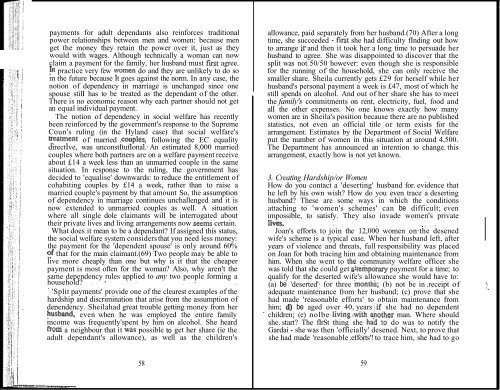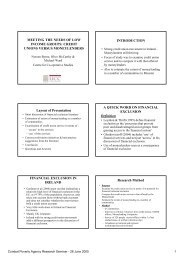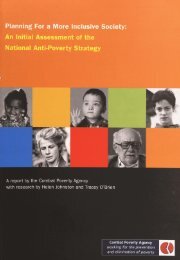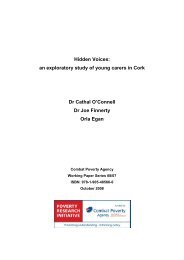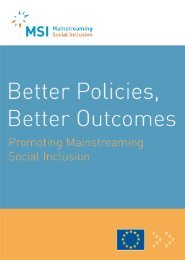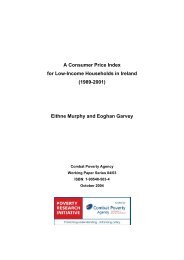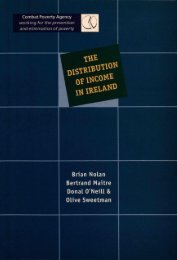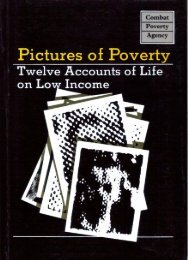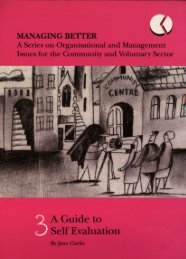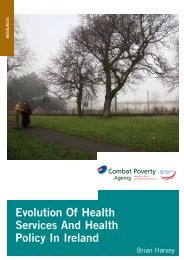Women and Poverty (1989) - Combat Poverty Agency
Women and Poverty (1989) - Combat Poverty Agency
Women and Poverty (1989) - Combat Poverty Agency
Create successful ePaper yourself
Turn your PDF publications into a flip-book with our unique Google optimized e-Paper software.
These are examples of how two families spent their money in<br />
early 1988.(32) Of course, this is only a snapshot of just one<br />
week out of fifty-two <strong>and</strong> gives little idea of the complex<br />
budgeting that frequently goes on in low income households<br />
<strong>and</strong> the financial pressures that arise at different points in<br />
time. They are useful, though, in providing a sense of the<br />
priorities <strong>and</strong> s~dard ofliving among poor families.<br />
Not surprisingly, shortages <strong>and</strong> deficits are common. In the<br />
case of Joan <strong>and</strong> Tom, the deficit is over a tenth of their<br />
weekly income - it is made up by short-term loans from<br />
members oftheir family. In Rose's case,just £1.70 is left over<br />
each week to cover shoes <strong>and</strong> clothes, entertainment, special<br />
occasions, among other things. Among the most notable<br />
features of these two cases are how little Rose spends on<br />
food: just £20 a week for herself <strong>and</strong> a young child; <strong>and</strong><br />
Joan's £13 a week on tobacco. She regards cigarettes as<br />
essential to her survival. Cigarettes are the lesser of two evils:<br />
if she did not smoke she would probably be on tranquillisers<br />
(which, ofcourse, she would get 'free' from the state).<br />
Survival Strategies<br />
<strong>Women</strong>. survive by using different strategies. One strategy is<br />
reducing spending, mainly by cutting down onfood <strong>and</strong>fuel.<br />
Spending on food is not a fixed cost among poor households<br />
but varies according to the money available. Often food is the<br />
only area where savings can be made. The man <strong>and</strong> the<br />
, children are put first: they get the best <strong>and</strong> biggest share of<br />
the food. For instance; when savings have to be made, the<br />
woman may not take any meat herself ensuring that others get<br />
some, or she may skip food at midday when the rest of the<br />
family are out. Lone mothers are particularly likely to cut<br />
back on their own food; it is more tempting for them to do so<br />
because they do not have another adult for whom to prepare a<br />
meal. Research, shows that, following a separation from their<br />
partners, lone mothers used their greater control over their<br />
money to cut down their eating.(33) But the lone mothers in<br />
that study would not swap their situation to go back to their<br />
husb<strong>and</strong>s: they, might have had more money, but they also had<br />
far less control over it.<br />
_<br />
Cutting down on food in this way affects women's nutrient<br />
intake <strong>and</strong> in the long term their health. Research shows that<br />
in a poorDublin suburb women eat less healthily than'men or<br />
children.(34) <strong>Women</strong>'s low iron, fibre <strong>and</strong> vitamin C intake,<br />
because they eat little meat <strong>and</strong> nutritious foods, is particularly<br />
worrying. In addition, they consume a lot of table sugl!!'<br />
mainly in cups of tea; The fact that children do not share theIr<br />
mothers' nutritional disadvantage shows that women sacrifice<br />
their own food intake.<br />
Cutting down on fuel is another way of saving. There are a<br />
number of creative, but hard; strategies for this. One can, for<br />
instance, put the children to bed early, sitting,on in the cold<br />
until one's own early bed-time. Another way of saving on<br />
food <strong>and</strong> fuel is to try <strong>and</strong> keep the children in bed until<br />
lunch-time at the weekends - this can save'one meal in the<br />
day.' Alternatively, extra layers of clothes can be worn. ' "<br />
Borrowing isa second survival strategy, usually it is money<br />
that is borrowed rather than goods. Weekly 'floats' - small<br />
amounts of money paid back almost immediately - are very<br />
common. Neighbours <strong>and</strong> family members help make up<br />
weekly shonagesin income:<br />
/ couldn't live without. my float. / get my mOney<br />
from my husb<strong>and</strong> on dole day -Thursday. / do my<br />
, big shopping that day at the supermarket. That's the<br />
,'day we have the best meal, usually with meat. From '<br />
then on my main shopping is buying bread <strong>and</strong> milk<br />
at the local shop. By Monday orTuesdayl'm out of<br />
money. Then / borrow maybe £/0 from my sister ~<br />
she can give it to me because she gets her money on '<br />
a Tuesday. / pay back what / owe her on Thursday<br />
so she can keep going.<br />
. . " . i· J<br />
Borrowing is more extensive than ~his" h?wever. Credit i~ a<br />
constant necessity for poor people <strong>and</strong> deqt a constant reality.<br />
To live on social welfare long termirneans having little or no<br />
money put by, either in savings ~r forIemergencies. This<br />
means that an'unexpected expense; even ajsmall one, can play<br />
havOc with the family's complicated financial balance. So t~e<br />
family, usually the woman, may beforceq to borrow fO!qUlte<br />
small '<strong>and</strong> routine expenses. For eXi1Tnple! up to two-thuds. of<br />
all loans taken out from moneylenders :may be' forrounne<br />
expenses, such as electricity <strong>and</strong> . other fuel bills, basic<br />
' '<br />
30<br />
3i


